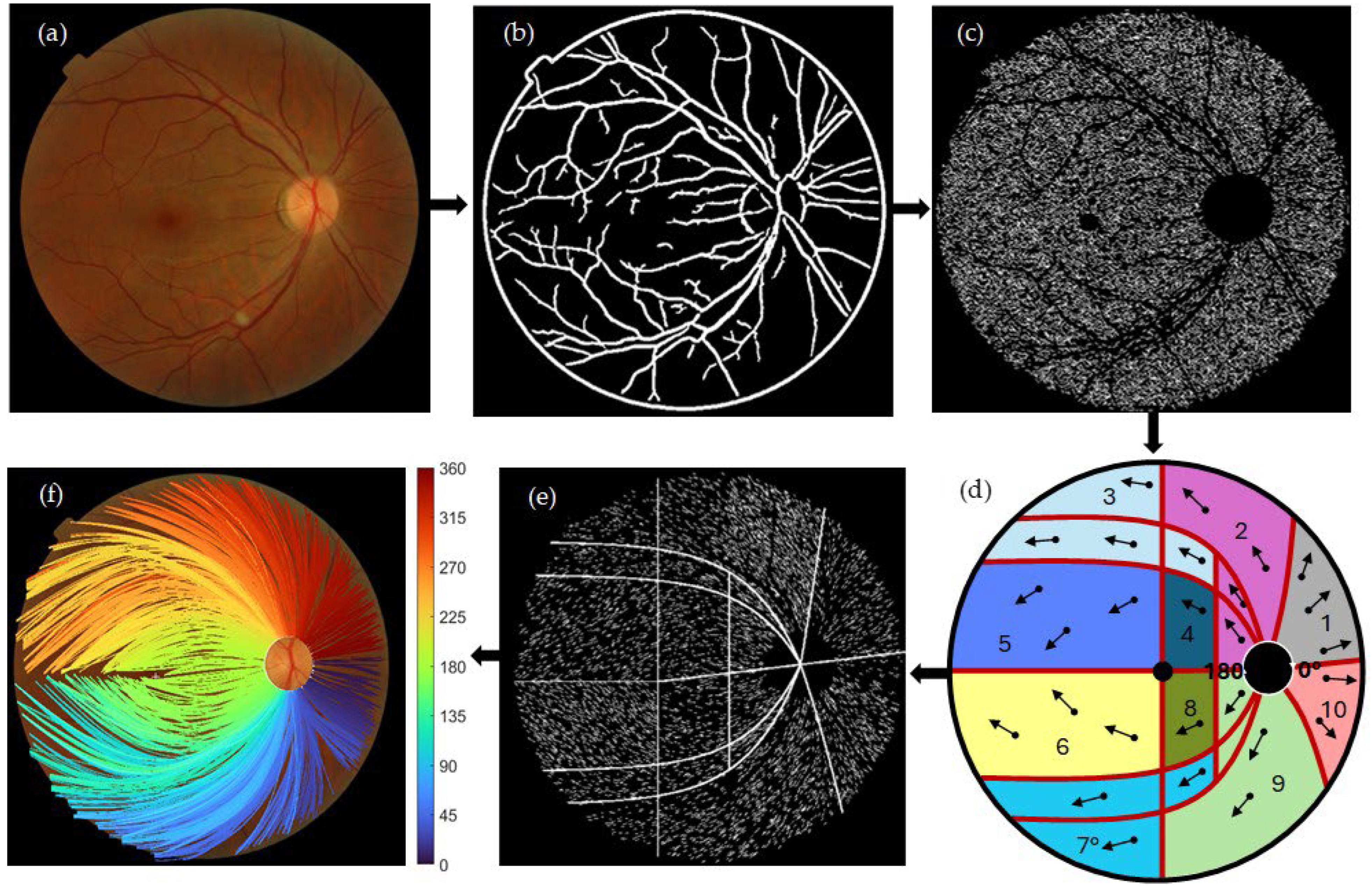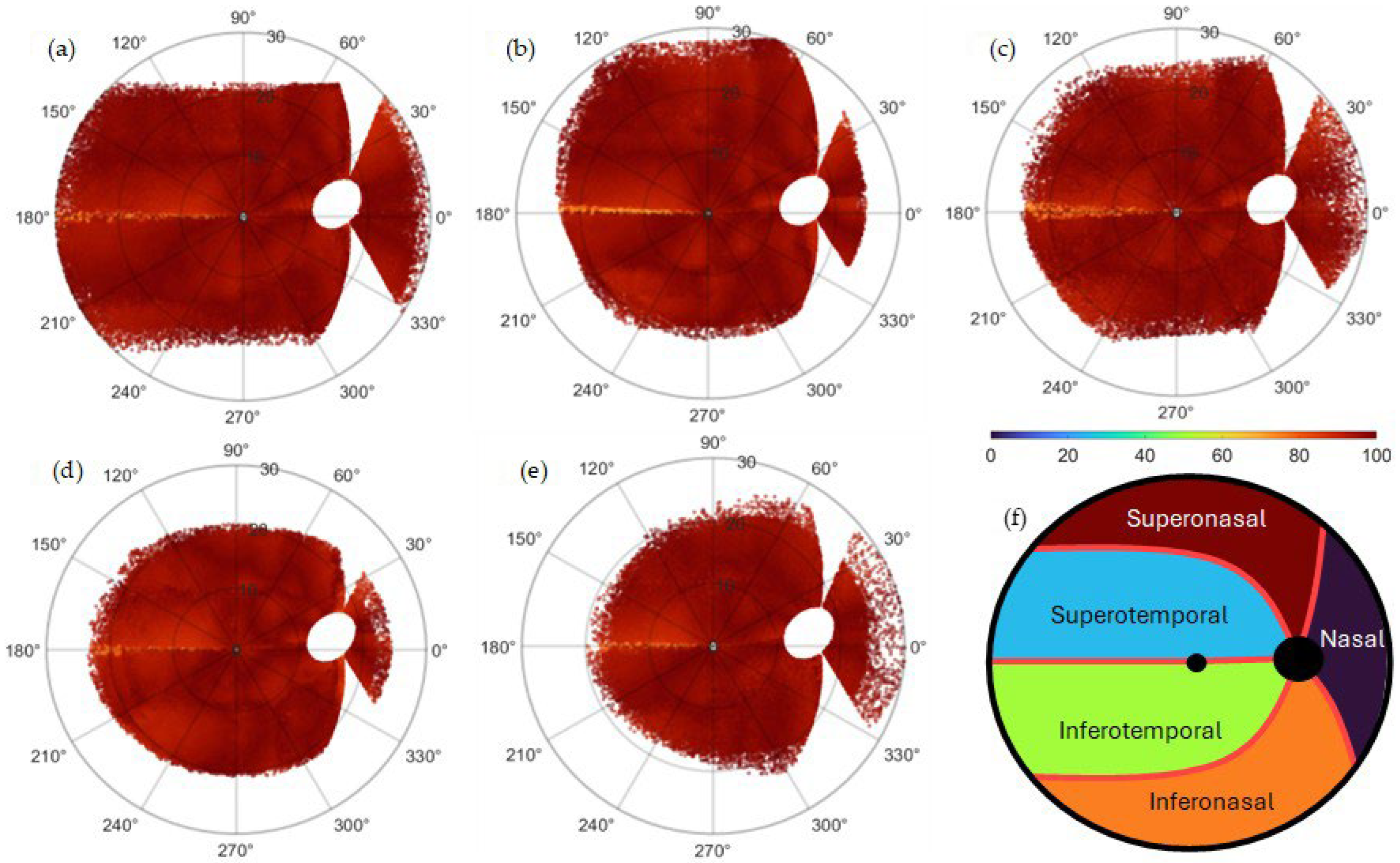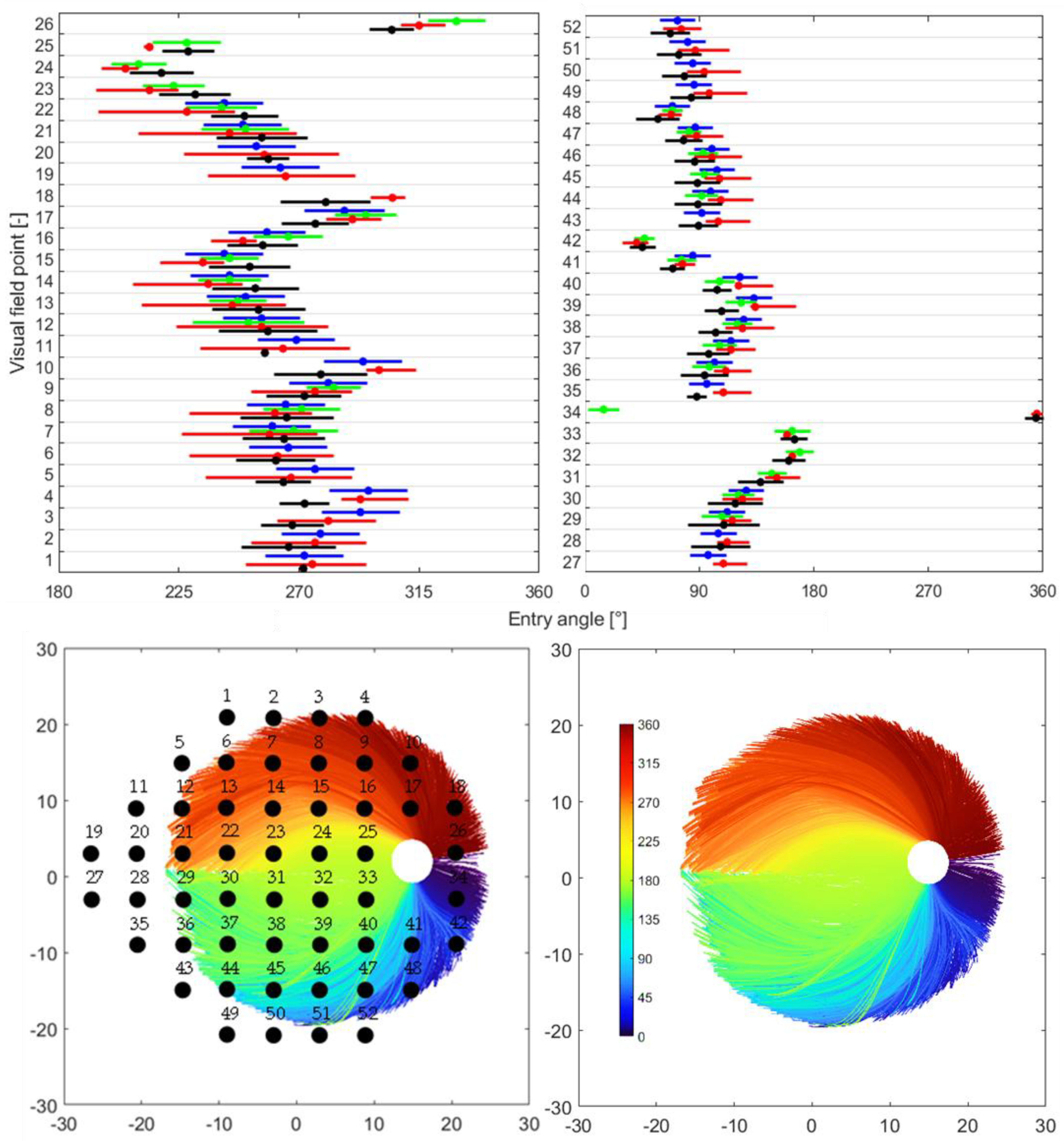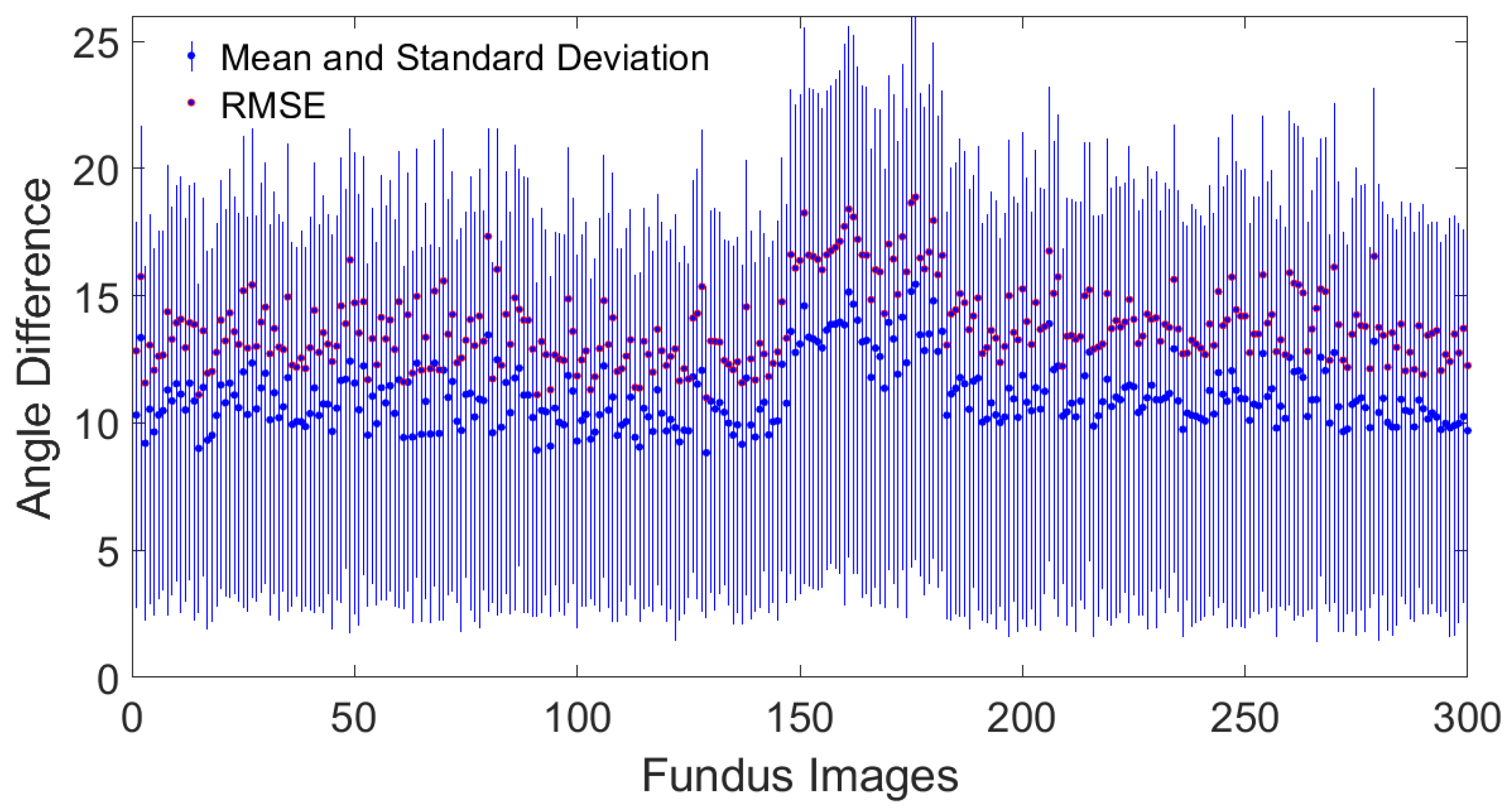Automatic Algorithm-Aided Segmentation of Retinal Nerve Fibers Using Fundus Photographs
Abstract
1. Introduction
2. Materials and Methods
2.1. Subjects and Fundus Photographs
2.2. Image Preprocessing
2.3. Segmentation of Personalized Mapping Algorithm
2.4. Ocular Parameters
2.5. Validation Procedure
2.5.1. Pointwise Validation (1st Test)
2.5.2. Structure–Function Mapping (2nd Test)
2.6. Statistical Analysis
3. Results
4. Discussion
4.1. Literature Review
4.2. Concordance and Discordance with Existing RNFL Bundle Paths
4.3. Quantitative Performance of the Structure–Function Map
4.4. Validation up to 30° of Eccentricity
4.5. Close Methodological Comparison of the Algorithm with Prior Literature
4.6. OD and FO Localization
4.7. Intersubject Variability for RNFL Bundle Traces
4.8. Limitations
5. Conclusions
Funding
Institutional Review Board Statement
Informed Consent Statement
Data Availability Statement
Conflicts of Interest
References
- Carreras, F.J.; Medina, J.; Ruiz-Lozano, M.; Carreras, I.; Castro, J.L. Virtual Tissue Engineering and Optic Pathways: Plotting the Course of the Axons in the Retinal Nerve Fiber Layer. Investig. Ophthalmol. Vis. Sci. 2014, 55, 3107–3119. [Google Scholar] [CrossRef] [PubMed]
- Shan, S.; Wu, J.; Cao, J.; Feng, Y.; Zhou, J.; Luo, Z.; Song, P.; Rudan, I.; Global Health Epidemiology Research Group (GHERG). Global incidence and risk factors for glaucoma: A systematic review and meta-analysis of prospective studies. J. Glob. Health 2024, 14, 04252. [Google Scholar] [CrossRef] [PubMed] [PubMed Central]
- Schiefer, U.; Flad, M.; Stumpp, F.; Malsam, A.; Paetzold, J.; Vonthein, R.; Oliver Denk, P.; Sample, P.A. Increased detection rate of glaucomatous visual field damage with locally condensed grids: A comparison between fundusoriented perimetry and conventional visual field examination. Arch. Ophthalmol. 2003, 121, 458–465. [Google Scholar] [CrossRef] [PubMed]
- Paetzold, J.; Sample, P.A.; Selig, B.; Krapp, E.; Vonthein, R.; Schiefer, U. Differentiation between glaucomatous scotoma progression in depth and in size by using scotoma-oriented perimetry (SCOPE) with locally condensed stimulus arrangements. Investigig. Ophthalmol. Vis. Sci. 2005, 46, 636. [Google Scholar]
- Denniss, J.; Allison, M.; McKendrick, A.T. An Anatomically Customizable Computational Model Relating the Visual Field to the Optic Nerve Head in Individual Eyes. Investig. Opthalmology Vis. Sci. 2012, 53, 6981–6990. [Google Scholar] [CrossRef]
- Sugita, M.; Pircher, M.; Zotter, S.; Baumann, B.; Roberts, P.; Makihira, T.; Tomatsu, N.; Sato, M.; Vass, C.; Hitzenberger, C.K. Retinal nerve fiber bundle tracing and analysis in human eye by polarization sensitive OCT. Biomed. Opt. Express 2015, 6, 1030–1054. [Google Scholar] [CrossRef] [PubMed] [PubMed Central]
- Iwata, K.; Namba, K.; Abe, H. Early fundus changes caused by repeated small crises in the PosnereSchlossman syndrome: A model for glaucoma simplex. Klin. Monbl. Augenheilkd. 1982, 180, 20–26. [Google Scholar] [CrossRef]
- Diekmann, H.; Fischer, D. Glaucoma and optic nerve repair. Cell Tissue Res. 2013, 353, 327–337. [Google Scholar] [CrossRef]
- Garway-Heath, D.F.; Poinoosawmy, D.; Fitzke, F.W.; Hitchings, R.A. Mapping the visual field to the optic disc in normal tension glaucoma eyes. Ophthalmology 2000, 107, 1809–1815. [Google Scholar] [CrossRef]
- Lamparter, J.; Russell, R.A.; Zhu, H.; Asaoka, R.; Yamashita, T.; Ho, T.; Garway-Heath, D.F. The Influence of Intersubject Variability in Ocular Anatomical Variables on the Mapping of Retinal Locations to the Retinal Nerve Fiber Layer and Optic Nerve Head. Investig. Ophthalmol. Vis. Sci. 2013, 54, 6074–6082. [Google Scholar] [CrossRef]
- Jansonius, N.M.; Nevalainen, J.; Selig, B.; Zangwill, L.M.; Sample, P.A.; Budde, W.M.; Jonas, J.B.; Lagrèze, W.A.; Airaksinen, P.J.; Vonthein, R. A mathematical description of nerve fiber bundle trajectories and their variability in the human retina. Vis. Res. 2009, 49, 2157–2163. [Google Scholar] [CrossRef]
- Leung, C.K.S.; Lam, A.K.N.; Weinreb, R.N.; Garway-Heath, D.F.; Yu, M.; Guo, P.Y.; Chiu, V.S.M.; Wan, K.H.N.; Wong, M.; Wu, K.Z.; et al. Diagnostic assessment of glaucoma and non-glaucomatous optic neuropathies via optical texture analysis of the retinal nerve fibre layer. Nat. Biomed. Eng. 2022, 6, 593–604. [Google Scholar] [CrossRef]
- Jansonius, N.M.; Schiefer, J.; Nevalainen, J.; Paetzold, J.; Schiefer, U. A mathematical model for describing the retinal nerve fiber bundle trajectories in the human eye: Average course, variability, and influence of refraction, optic disc size and optic disc position. Exp. Eye Res. 2012, 105, 70–78. [Google Scholar] [CrossRef] [PubMed]
- Chen, Z.; Shemuelian, E.; Wollstein, G.; Wang, Y.; Ishikawa, H.; Schuman, J.S. Segmentation-Free OCT-Volume-Based Deep Learning Model Improves Pointwise Visual Field Sensitivity Estimation. Trans. Vis. Sci. Tech. 2023, 12, 28. [Google Scholar] [CrossRef] [PubMed]
- Park, K.; Kim, J.; Lee, J. A deep learning approach to predict visual field using optical coherence tomography. PLoS ONE 2020, 15, e0234902. [Google Scholar] [CrossRef] [PubMed] [PubMed Central]
- Christopher, M.; Bowd, C.; Belghith, A.; Goldbaum, M.H.; Weinreb, R.N.; Fazio, M.A.; Girkin, C.A.; Liebmann, J.M.; Zangwill, L.M. Deep Learning Approaches Predict Glaucomatous Visual Field Damage from OCT Optic Nerve Head En Face Images and Retinal Nerve Fiber Layer Thickness Maps. Ophthalmology 2020, 127, 346–356. [Google Scholar] [CrossRef]
- Leung, C.K.S.; Cheung, C.Y.L.; Weinreb, R.N.; Qiu, K.; Liu, S.; Li, H.; Xu, G.; Fan, N.; Pang, C.P.; Tse, K.K.; et al. Evaluation of retinal nerve fiber layer progression in glaucoma with optical coherence tomography guided progression analysis. Investig. Ophthalmol. Vis. Sci. 2009, 11, 5172–5178. [Google Scholar] [CrossRef]
- Weber, J.; Ulrich, H. A perimetric nerve fiber bundle map. Int. Ophthalmol. 1991, 15, 193–200. [Google Scholar] [CrossRef]
- Wigelius, O. A Model for the Retinal Nerve Fiber Layer. Master’s Thesis, Lund University, Lund, Sweden, 2001. [Google Scholar]
- Ferreras, A.; Pablo, L.E.; Garway-Heath, D.F.; Fogagnolo, P.; Garcia-Feijoo, J. Mapping standard automated perimetry to the peripapillary retinal nerve fiber layer in glaucoma. Investig. Ophthalmol. Vis. Sci. 2008, 49, 3018–3025. [Google Scholar] [CrossRef] [PubMed]
- Turpin, A.; Sampson, G.P.; McKendrick, A.M. Combining ganglion cell topology and data of patients with glaucoma to determine a structure-function map. Investig. Ophthalmol. Vis. Sci. 2009, 50, 3249–3256. [Google Scholar] [CrossRef]
- Denniss, J.; Turpin, A.; Tanabe, F.; Matsumoto, C.; McKendrick, A.M. Structure-function mapping: Variability and conviction in tracing retinal nerve fiber bundles and comparison to a computational model. Investig. Ophthalmol. Vis. Sci. 2014, 55, 728–736. [Google Scholar] [CrossRef][Green Version]
- Oh, J.E.; Yang, H.K.; Kim, K.G.; Hwang, J.-M. Automatic computer-aided diagnosis of retinal nerve fiber layer defects using fundus photographs in optic neuropathy. Investig. Ophthalmol. Vis Sci. 2015, 56, 2872–2879. [Google Scholar] [CrossRef] [PubMed]
- Quintana-Quintana, O.J.; Aceves-Fernández, M.A.; Pedraza-Ortega, J.C.; Alfonso-Francia, G.; Tovar-Arriaga, S. Deep Learning Techniques for Retinal Layer Segmentation to Aid Ocular Disease Diagnosis: A Review. Computers 2025, 14, 298. [Google Scholar] [CrossRef]
- Zhang, H.; Yang, B.; Li, S.; Zhang, X.; Li, X.; Liu, T.; Higashita, R.; Liu, J. Retinal OCT image segmentation with deep learning: A review of advances, datasets, and evaluation metrics. Comput. Med. Imaging Graph. 2025, 123, 102539. [Google Scholar] [CrossRef]
- Budai, A.; Bock, R.; Maier, A.; Hornegger, J.; Michelson, G. Robust Vessel Segmentation in Fundus Images. Int. J. Biomed. Imaging 2013, 2013, 154860. [Google Scholar] [CrossRef] [PubMed]
- Cen, L.P.; Ji, J.; Lin, J.W.; Ju, S.T.; Lin, H.J.; Li, T.P.; Wang, Y.; Yang, J.F.; Liu, Y.F.; Tan, S.Y. Automatic detection of 39 fundus diseases and conditions in retinal photographs using deep neural networks. Nat. Commun. 2021, 12, 4828. [Google Scholar] [CrossRef]
- Akram, M.U.; Abdul Salam, A.; Khawaja, S.G.; Naqvi, S.G.H.; Khan, S.A. RIDB: A Dataset of fundus images for retina based person identification. Data Brief 2020, 33, 106433. [Google Scholar] [CrossRef] [PubMed] [PubMed Central]
- Hu, Q.; Abràmoff, M.D.; Garvin, M.K. Automated separation of binary overlapping trees in low-contrast color retinal images. Med. Image. Comput. Comput. Assist Interv. 2013, 16 Pt 2, 436–443. [Google Scholar] [PubMed]
- Decencière, E.; Zhang, X.; Cazuguel, G.; Lay, B.; Cochener, B.; Trone, C.; Gain, P.; Ordonez, R.; Massin, P.; Erginay, A.; et al. Feedback on a publicly distributed database: The Messidor database. Image Anal. Stereol. 2014, 33, 231–234. [Google Scholar] [CrossRef]
- Jansonius, N.M.; Schiefer, U. Anatomical location of the raphe and extended raphe in the human retina: Implications for assessment of the optic nerve with OCT. Trans. Vis. Sci. Tech. 2020, 9, 3. [Google Scholar] [CrossRef]
- Khalid, N.E.A.; Noor, N.M.; Mahmud, Z.; Yahya, S.; Ariff, N.M. Bridging Quantitative and Qualitative of glaucoma detection. World Acad. Sci. Eng. Technol. 2012, 6, 584–588. [Google Scholar]
- Fraz, M.M.; Basit, A.; Barman, S. Application of morphological bit planes in retinal blood vessel extraction. J. Digit. Imaging 2013, 26, 274–286. [Google Scholar] [CrossRef]
- Fraz, M.M.; Remagnino, P.; Hoppe, A.; Uyyanonvara, B.; Rudnicka, A.R.; Owen, C.G.; Barman, S.A. Blood vessel segmentation methodologies in retinal images—A survey. Comput. Methods Programs Biomed. 2012, 108, 407–433. [Google Scholar] [CrossRef]
- Zuiderveld, K. Contrast Limited Adaptive Histograph Equalization. In Graphic Gems IV; Academic Press Professional: San Diego, CA, USA, 1994; pp. 474–485. [Google Scholar]
- Frangi, A.F.; Niessen, W.J.; Vincken, K.L.; Viergever, M.A. Multiscale vessel enhancement filtering. In Proceedings of the International Conference on Medical Image Computing and Computer-Assisted Intervention—MICCAI’98, Cambridge, MA, USA, 11–13 October 1998; Springer: Berlin/Heidelberg, Germany, 1998; pp. 130–137. [Google Scholar]
- Ohad, G. fit_ellipse. MATLAB Central File Exchange. 2025. Available online: https://www.mathworks.com/matlabcentral/fileexchange/3215-fit_ellipse (accessed on 13 May 2025).
- Leung, C.K.S.; Guo, P.Y.; Lam, A.K.N. Retinal Nerve Fiber Layer Optical Texture Analysis: Involvement of the Papillomacular Bundle and Papillofoveal Bundle in Early Glaucoma. Ophthalmology 2022, 129, 1043–1055. [Google Scholar] [CrossRef]
- Fitzgibbon, T.; Taylor, S.F. Retinotopy of the human retinal nerve fibre layer and optic nerve head. J. Comp. Neurol. 1996, 375, 238–251. [Google Scholar] [CrossRef]
- Vrabec, F. The temporal raphe of the human retina. Am. J. Ophthalmol. 1966, 62, 926–938. [Google Scholar] [CrossRef] [PubMed]
- Garvin, M.K.; Abramoff, M.D.; Lee, K.; Niemeijer, M.; Sonka, M.; Kwon, Y.H. 2-D pattern of nerve fiber bundles in glaucoma emerging from spectral-domain optical coherence tomography. Investig. Ophthalmol. Vis. Sci. 2012, 53, 483–489. [Google Scholar] [CrossRef] [PubMed]
- Bikbov, M.M.; Iakupova, E.M.; Gilmanshin, T.R.; Bikbova, G.M.; Kazakbaeva, G.M.; Panda-Jonas, S.; Gilemzianova, L.I.; Jonas, J.B. Prevalence and associations of nonglaucomatous optic nerve atrophy in high myopia: The ural eye and medical study. Ophthalmology 2023, 130, 1174–1181. [Google Scholar] [CrossRef]
- Hood, D.C.; Fortune, B.; Arthur, S.N.; Xing, D.; Salant, J.A.; Ritch, R.; Liebmann, J.M. Blood vessel contributions to retinal nerve fiber layer thickness profiles measured with optical coherence tomography. J. Glaucoma. 2008, 17, 519–528. [Google Scholar] [CrossRef] [PubMed]
- Hood, D.C.; Salant, J.A.; Arthur, S.N.; Ritch, R.; Liebmann, J.M. The location of the inferior and superior temporal blood vessels and inter-individual variability of the retinal nerve fiber layer thickness. J. Glaucoma. 2010, 19, 158–166. [Google Scholar] [CrossRef]
- Jonas, J.B.; Nguyen, N.X.; Naumann, G.O.H. The retinal nerve fiber layer in normal eyes. Ophthalmology 1989, 96, 627–632. [Google Scholar] [CrossRef]
- Jonas, J.B.; Schiro, D. Visibility of the normal retinal nerve fiber layer correlated with rim width and vessel caliber. Graefe’s Arch. Clin. Exp. Ophthalmol. 1993, 231, 207–211. [Google Scholar] [CrossRef]
- Airaksinen, P.J.; Alanko, H.I. Effect of retinal nerve fibre loss on the optic nerve head configuration in early glaucoma. Graefes Arch. Clin. Exp. Ophthalmol. 1983, 220, 193–196. [Google Scholar] [CrossRef] [PubMed]
- Radius, R.L.; Anderson, D.R. The course of axons through the retina and optic nerve head. Arch. Ophthalmol. 1979, 97, 1154–1158. [Google Scholar] [CrossRef]
- Minckler, D.S. The organization of nerve fiber bundles in the primate optic nerve head. Arch. Ophthalmol. 1980, 98, 1630–1636. [Google Scholar] [CrossRef]
- Hood, D.C.; Raza, A.S.; de Moraes, C.G.V.; Liebmann, J.M.; Ritch, R. Glaucomatous damage of the macula. Prog. Retin. Eye Res. 2013, 32, 1–21. [Google Scholar] [CrossRef] [PubMed]
- Hogan, M.; Alvardo, J.; Weddell, J. Histology of the Human Eye; WB Saunders: Philadelphia, PA, USA, 1971; pp. 523–606. [Google Scholar]
- Tanabe, F.; Matsumoto, C.; Okuyama, S.; Takada, S.; Hashimoto, S.; Arimura, E.; Nomoto, H.; Kayazawa, T.; Eura, M.; Shimomura, Y. Factors in the Retinal Nerve Fiber Layer (RNFL) Bundle Angles at the Optic Disc. IVFIS 2012. Available online: https://www.perimetry.org/__static/1dee4d2e5ebbc3d8091e1c689c10b1f5/20-melbourne.pdf?dl=1 (accessed on 15 August 2025).
- Hwang, Y.H.; Yoo, C.; Kim, Y.Y. Characteristics of peripapillary retinal nerve fiber layer thickness in eyes with myopic optic disc tilt and rotation. J. Glaucoma. 2012, 21, 394–400. [Google Scholar] [CrossRef] [PubMed]
- Tong, L.; Chan, Y.H.; Gazzard, G.; Loon, S.C.; Fong, A.; Selvaraj, P.; Healey, P.R.; Tan, D.; Wong, T.Y.; Saw, S.M. Heidelberg retinal tomography of optic disc and nerve fiber layer in Singapore children: Variations with disc tilt and refractive error. Investig. Ophthalmol. Vis Sci. 2007, 48, 4939–4944. [Google Scholar] [CrossRef]
- Jonas, J.B.; Jonas, R.A.; Bikbov, M.M.; Wang, Y.X.; Panda-Jonas, S. Myopia: Histology, clinical features, and potential implications for the etiology of axial elongation. Prog. Retin. Eye Res. 2023, 96, 101156. [Google Scholar] [CrossRef] [PubMed]
- Yii, F.; Gibbon, S.; MacGillivra, T. Sectoral Changes in Neuroretinal Rim Pallor Across Refractive Error. Ophthalmol. Sci. 2025, 5, 100705. [Google Scholar] [CrossRef]
- Jonas, J.B.; Xu, L.; Wei, W.B.; Pan, Z.; Yang, H.; Holbach, L.; Panda-Jonas, S.; Wang, Y.X. Retinal Thickness and Axial Length. Investig. Ophthalmol. Vis. Sci. 2016, 57, 1791–1797. [Google Scholar] [CrossRef]
- Yoo, Y.C.; Lee, C.M.; Park, J.H. Changes in peripapillary retinal nerve fiber layer distribution by axial length. Optom. Vis. Sci. 2012, 89, 4–11. [Google Scholar] [CrossRef] [PubMed]
- Hong, S.W.; Ahn, M.D.; Kang, S.H.; Im, S.K. Analysis of peripapillary retinal nerve fiber distribution in normal young adults. Investig. Ophthalmol. Vis. Sci. 2010, 51, 3515–3523. [Google Scholar] [CrossRef] [PubMed]
- Yamashita, T.; Asaoka, R.; Tanaka, M.; Kii, Y.; Yamashita, T.; Nakao, K.; Sakamoto, T. Relationship Between Position of Peak Retinal Nerve Fiber Layer Thickness and Retinal Arteries on Sectoral Retinal Nerve Fiber Layer Thickness. Investig. Ophthalmol. Vis. Sci. 2013, 54, 5481–5488. [Google Scholar] [CrossRef]
- Bedggood, P.; Mukherjee, S.; Bao, N.; Nguyen, A.T.; Allison, M. McKendrick; Geometry of the Retinal Nerve Fibers From Emmetropia Through to High Myopia at Both the Temporal Raphe and Optic Nerve. Investig. Ophthalmol. Vis. Sci. 2019, 60, 4896–4903. [Google Scholar] [CrossRef] [PubMed]
- Jerman, T.; Pernus, F.; Likar, B.; Spiclin, Z. Enhancement of Vascular Structures in 3D and 2D Angiographic Images. IEEE Trans. Med. Imaging 2016, 35, 2107–2118. [Google Scholar] [CrossRef]





| Database | Nasal | Superotemporal | Inferotemporal | Inferonasal | Superonasal | Average |
|---|---|---|---|---|---|---|
| HRF | 93.32 | 94.62 | 99.07 | 99.22 | 99.88 | 97.22 |
| JSIEC | 85.48 | 90.10 | 98.51 | 97.63 | 99.74 | 94.30 |
| RIDB | 95.77 | 95.29 | 98.41 | 99.86 | 99.80 | 97.82 |
| DRIVE | 87.41 | 89.75 | 97.27 | 97.66 | 99.74 | 94.37 |
| MESSIDOR | 97.60 | 90.89 | 98.61 | 99.69 | 99.84 | 97.32 |
| Independent Variable | Coefficient | R2 | F-Statistic | p-Value |
|---|---|---|---|---|
| Longitudinal OD position | 2.67 × 10−1 | 8.10 × 10−3 | 2.27 × 100 | 1.32 × 10−1 |
| Latitudinal OD position | −4.43 × 100 | 6.40 × 10−1 | 4.87 × 102 | 3.75 × 10−63 |
| OD area | −2.95 × 10−2 | 3.90 × 10−3 | 1.10 × 100 | 2.96 × 10−1 |
| FOV size | −6.20 × 10−3 | 7.40 × 10−2 | 2.23 × 101 | 3.71 × 10−1 |
| Ellipticity ratio | 3.16 × 100 | 1.70 × 10−3 | 4.81 × 10−1 | 4.95 × 10−1 |
| Disk–fovea angle | −1.56 × 100 | 6.20 × 10−1 | 4.55 × 102 | 1.42 × 10−60 |
Disclaimer/Publisher’s Note: The statements, opinions and data contained in all publications are solely those of the individual author(s) and contributor(s) and not of MDPI and/or the editor(s). MDPI and/or the editor(s) disclaim responsibility for any injury to people or property resulting from any ideas, methods, instructions or products referred to in the content. |
© 2025 by the author. Licensee MDPI, Basel, Switzerland. This article is an open access article distributed under the terms and conditions of the Creative Commons Attribution (CC BY) license (https://creativecommons.org/licenses/by/4.0/).
Share and Cite
Luján Villarreal, D. Automatic Algorithm-Aided Segmentation of Retinal Nerve Fibers Using Fundus Photographs. J. Imaging 2025, 11, 294. https://doi.org/10.3390/jimaging11090294
Luján Villarreal D. Automatic Algorithm-Aided Segmentation of Retinal Nerve Fibers Using Fundus Photographs. Journal of Imaging. 2025; 11(9):294. https://doi.org/10.3390/jimaging11090294
Chicago/Turabian StyleLuján Villarreal, Diego. 2025. "Automatic Algorithm-Aided Segmentation of Retinal Nerve Fibers Using Fundus Photographs" Journal of Imaging 11, no. 9: 294. https://doi.org/10.3390/jimaging11090294
APA StyleLuján Villarreal, D. (2025). Automatic Algorithm-Aided Segmentation of Retinal Nerve Fibers Using Fundus Photographs. Journal of Imaging, 11(9), 294. https://doi.org/10.3390/jimaging11090294







